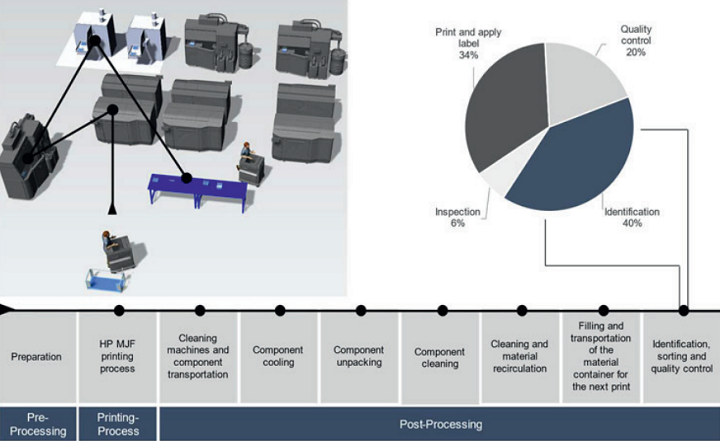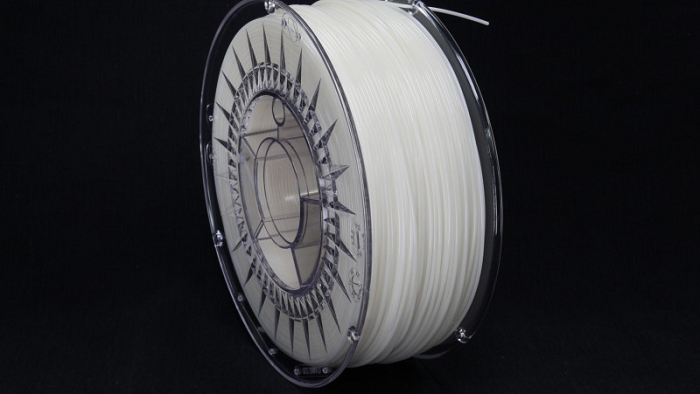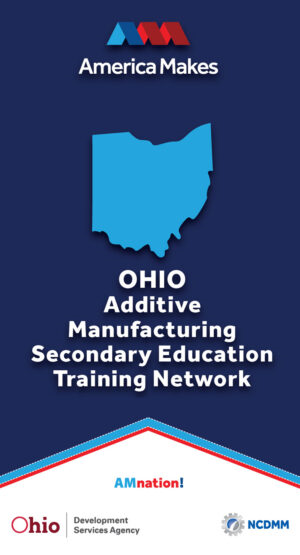3D Printing News Briefs, July 11, 2021: Wohler’s Associates; Solvay, Ultimaker, and L’Oréal; America Makes & ODSA; BMW Group; Dartmouth College; BEAMIT & Elementum 3D; Covestro & Nexeo Plastics; Denizen
In today’s 3D Printing News Briefs, we’ll be telling you about the launch of an audio series and a competition, AM training and research efforts, materials, and more. Read on for the details!
Wohler’s Associates Launches AM Audio Series
Recently, independent consulting firm Wohler’s Associates, Inc. announced the launch of its new Wohlers Audio Series, which is all about additive manufacturing and sharing insight from AM industry experts on how to apply the technology and where they think it’s headed. Wohler’s plans to cover a wide variety of subjects in the series, including the development of 3D printing materials, such as photopolymers and polymer powders.
The first episode of the series features a conversation between Founder and President Terry Wohlers and Noah Mostow, the firm’s Director of Market Intelligence and Publications. They discuss both the origin and the future of the Wohler’s Report, which was first published 26 years ago and is considered, as Wohler’s puts it, the “undisputed” industry report on 3D printing around the world. You can listen to the first episode on Spotify, YouTube, Apple Podcasts, and on the Wohler’s Associates website.
Third Edition of Additive Manufacturing Cup

L-R: Solvay’s range of AM-ready materials; agile manufacturing used for lipstick manufacturing within a L’Oréal production facility; Ultimaker S5 with the Air Manager.
Back in 2017, Belgian chemical group Solvay launched the first international AM Cup competition, catered to university students and centered around the difficult organic thermoplastic PEEK. Now, along with partners Ultimaker and L’Oréal, Solvay has announced the third edition of the 3D printing design challenge, which gives engineers, manufacturers, and students around the world the chance to integrate and accelerate today’s industrial manufacturing processes by creating an innovative design for a real 3D printed application. Participants must use a material from Solvay’s portfolio of high-performance AM materials, comprising Solef polyvinylidene fluoride (PVDF), KetaSpire polyetheretherketone (PEEK) and Radel polyphenylsulfone (PPSU) filaments.
“Solvay’s AM Cup was introduced to showcase Solvay’s array of AM ready filaments and their potential for diverse complex industrial uses. We are pleased to collaborate with L’Oréal who offer a tangible and challenging industrial application and partner with Ultimaker to 3D print our candidates’ designs for assessment,” said Brian Alexander, AM Global Product & Application Manager at Solvay. “Solvay continues to build a robust and diversified AM ecosystem encompassing key partnerships in the value chain to offer our customers high-performance 3D printable polymers and meet the rapid developments of a once niche-technology.”
The competition begins on September 1st, ending in mid-November, and candidates have until September 30th to register their interest in participating; the winner will be announced in January of 2022. You can learn more about the competition via Solvay’s AM Cup portal.
America Makes Announces New Ohio AM Training Network
In order to address the lack of skilled AM workers across the state of Ohio, America Makes has announced the Ohio Secondary Education Additive Manufacturing Training Network. The program, funded through the Fiscal Year 2020-21 State of Ohio operations budget, was created with support from, and collaboration with, the Ohio Development Services Agency (ODSA), and is meant to build a talent pipeline to prepare students in Ohio for future careers in the 3D printing industry. The network will provide formal education and AM training to high school students, and their educators, in order to take on the manufacturing skills gap and make sure that the next generation of workers in the state can fill AM industry jobs.
“There’s no question that our state and our nation are facing a significant skilled labor shortage and misalignment of skills and competencies. We need to take action now with K-12 students, with immediate emphasis on focusing on secondary education students and empowering their educators—from teachers to principals and guidance counselors—to help them increase students’ awareness of AM technologies and advanced manufacturing careers. The awareness vacuum around manufacturing career opportunities is an even larger issue than the skills gap,” stated Josh Cramer, America Makes Education & Workforce Development Director. “With the creation of the Ohio Secondary Education Additive Manufacturing Training Network, we are building that critically needed additive talent pipeline across the state of Ohio.”
The 10 secondary schools participating in the network initially are the Grant Career Center, the Horizon Science Academy Columbus High School, the Apollo Career Center, Ashtabula County Technical and Career Center (A-Tech), Butler Tech, MCCTC and Valley Stem, the Dayton Regional STEM School, Windham Exempted Village Schools, Theodore Roosevelt High School, and Marietta High School. Each one will receive six Dremel DigiLab 3D45 Advanced Idea Builder 3D Printer bundles with materials and supplies, as well as support for community engagement activities and participation in national AM events, like RAPID+TCT.
Research on AI for Automated AM Parts Recognition

Figure 2: Simplified overall AM process chain using HP MJF technology with percentage duration of operations for manual component identification (Time measurement by AM-Flow)
A trio of researchers, led by the BMW Group‘s Philip Obst, had been working on a research project ahead of the recent Rapid.Tech 3D Conference 2021, called “AM on the way to industrialization,” and published a paper on their work, titled “Complexity and economical value of Artificial Intelligence for automated and industrialized recognition of additive manufactured components.” According to the paper, the current AM process chain still has a lot of labor-intensive work, which can lead to increased costs, decreased product throughput, and bottlenecks. The researchers looked into the economic viability of the AM-VISION industrial machine by AM-Flow, which identifies AM components, based on their own unique geometries, using cameras and machine learning algorithms.
“Additive manufacturing (AM) is at a turning point towards industrialization and automation. Due to the ever shorter product development time in the automotive industry, the need for flexible production methods is increasing, and with it the need to manufacture larger quantities of prototype components. Therefore, there is a growing effort to further optimize and increase the efficiency of AM technologies and their process chain, which decisively shortens the way to series production. The current identification of AM components at the end of the overall process chain represents a non-scalable and cost-intensive manual, labor intensive process. The variety of geometries in prototyping leads to complex challenges where existing automation solutions cannot be implemented. AI- based image recognition can be an improvement in this regard. An analysis with regard to complexity, functionality and deployment will provide information about the economic efficiency of the automatic identification of prototype components.”
You can read the rest of the paper here.
Dartmouth Researchers’ Kinetic Trapping Process
Researchers in the Ke Functional Materials Group at Dartmouth College published a study, “Kinetic trapping of 3D-printable cyclodextrin-based poly(pseudo)rotaxane networks,” about their new process called kinetic trapping, which uses heat to change the arrangement of molecular rings on a chemical train, thus creating 3D printable gels that have some interesting functional properties. Molecular stoppers regulate how many rings go into a polymer chain, as well as how they’re distributed. When they’re bunched up together, the rings store kinetic energy that can be released, and the team took advantage of this to change the ring distribution, using heat, and then activated different shapes of the 3D printed object using different moisture levels.
“This new method uses heat to produce and control 3D inks with varieties of properties. It’s a process that could make the 3D printing of complex objects easier and less expensive,” explained Chenfeng Ke, an assistant professor of chemistry and the senior researcher on the study.
“The different parts of this object come from the same printing ink. They have similar chemical compositions but different numbers of molecular rings and distributions. These differences give the product drastically different mechanical strengths and cause them to respond to moisture differently.”
To learn more, check out the study here. For a demonstration, check out the video below of a flower, 3D printed with an ink created from this process, that closes when exposed to moisture:
BEAMIT’s AM Process for Al2024 RAM2C Aluminum Alloy

BEAMIT has developed an Additive Manufacturing process for Al2024 RAM2C aluminum alloy (Image courtesy the BEAMIT Group)
In response to growing demand, Italian company the BEAMIT Group has come up with a 3D printing process for using the high-performance, ultralight Al2024 RAM2C aluminum alloy. BEAMIT collaborated with Elementum 3D, using its Al2024-RAM2C material—a 2000 series aluminum alloy composition that’s been modified with the company’s patented RAM additions. Until recently, this type of alloy was known for being unable to be processed using 3D printing due to their composition, but BEAMIT built a custom heat treatment cycle for the 2024 RAM2C alloy in order to get the best properties. The Al2024 RAM2C aluminum alloy is said to perform well at high temperatures, as well as being tough and extremely lightweight, which makes it a good choice for aeronautical, automotive, and motorsport industries.
“It is very difficult to process 2000 series aluminium alloys via L-PBF [Laser Beam Powder Bed Fusion], so developing this material really motivated us,” explained Alessandro Rizzi, BEAMIT Group Material and Special Processes Manager. “Furthermore, the role of heat treatments became fundamentally important for Al2024 RAM2C and enabled us to experiment different ones to find repeatable stable processes and guarantee maximum performance, including in-air and HIP-Q treatments.”
Covestro & Nexeo Plastics Partner for New PC/ABS Filament

The new polycarbonate blend for 3D printing developed by Covestro and Nexeo, Addigy FPB 2684 3D, is available in black and white and in filament diameters of 1.75 and 2.85 millimeters. (Image courtesy of Covestro)
Speaking of materials partnerships, material manufacturer Covestro and global thermoplastic resin distributor Nexeo Plastics partnered up to develop and launch a new polycarbonate (PC)/ABS 3D printing filament, called Addigy FPB 2684 3D, that’s available through Nexeo’s distribution platform in 1.75 and 2.85 mm diameters. Nexeo Plastics used its technical support services experience for testing scenarios based on real-world 3D printing demands to promote the development of the material, while Ultimaker co-developed the print parameters of the material for its S3 and S5 series printers. The filament is tough and UV-resistant in environments with temperatures up to 122°C, featuring a smooth surface finish, superior strength, and impact resistance. While it’s currently only available in black and white, a wider range of colors will be added to the PC/ABS portfolio later in the year per customer requests.
“For the last couple of years Nexeo Plastics and Covestro have worked extensively on customer applications and material requirements for OEMs,” explained Patrick Rosso, Global Head of Additive Manufacturing at Covestro. “This collective know-how has built the foundation on which the product is being launched on the Ultimaker Cura platform in order to offer our customers the most convenient and reliable PC-printing solution.”
Pre-Fab Smartpod Offices Available By Subscription
If you’re tired of working at your dining room table but aren’t quite ready to go back into the office yet because of the ongoing pandemic, then I have a solution for you—the Denizen Archetype, a prefabricated, 100 square foot smartpod office space that’s available by subscription to employers in order to lower central office costs. The company says the pod can be installed almost anywhere and moved pretty easily, and calls it more of a smartphone than a traditional building, as it’s “suited for high-volume production as a consumer product.” Denizen utilizes biopolymer 3D printing, technology integration, metal cladding, and robotic fabrication to produce these little office pods at a faster rate of speed, and the pods feature apparently switchable privacy glass, speakers, and require a 40 Amp electrical service.
“There is a major unmet need in the shift to flexible, remote, and hybrid work, and it’s going to take conventional real estate decades to catch up. Even prior to the pandemic, offices were expensive, distracting, and inconvenient. A better solution was needed. We’ve created a space so inspiring that it will change the way you want to work and live. And by offering it as a subscription service, we make it natural for employers to give their teams a professional, connected, and safe work environment,” Nick Foley, the Founder of California-based Denizen, explained to Treehugger.
“When remote work is this good, a human-centered capitalism emerges, where people can always connect with opportunities to make their passions their livelihood and collaborate effortlessly on hard problems. Our vision is to partner with cities to deploy pods unobtrusively in underutilized greenspace for shared use at the neighborhood level. Not everyone has the at-home option for a great workspace, but everyone occasionally needs one. We can start reshaping our cities – less space for cars, office parks, and parking lots; more space for people, culture, and nature. World-class remote tech is also a critical tool for eliminating the carbon impact of business flights – we’ve built a workspace that is just as good, if not better, than being in person.”
We’ve seen something similar at the Port of Rotterdam, though a bit smaller, so clearly the idea is catching on. The big question, of course, is if companies will be willing to pay for their employees to use these little smartpods.
Subscribe to Our Email Newsletter
Stay up-to-date on all the latest news from the 3D printing industry and receive information and offers from third party vendors.
You May Also Like
Further Understanding of 3D Printing Design at ADDITIV Design World
ADDITIV is back once again! This time, the virtual platform for additive manufacturing will be holding the first-ever edition of ADDITIV Design World on May 23rd from 9:00 AM –...
3D Printer Maker EVO-tech Reborn as NEVO3D — Once More With Feeling
EVO-tech was a 3D printing service and original equipment manufacturer established in 2013 and based in Schörfling am Attersee, Austria. The company produced high-quality material extrusion systems featuring linear bearings,...
3D Systems Brings 3D Printed PEEK Cranial Implant to the U.S. with FDA Clearance
For more than 10 years, 3D Systems (NYSE:DDD) has worked hand-in-hand with surgeons to plan over 150,000 patient-specific cases, and develop more than two million instruments and implants from its...
CDFAM Returns to Berlin for Second Annual Symposium
The second CDFAM Computational Design Symposium is scheduled for May 7-8, 2024, in Berlin, and will convene leading experts in computational design across all scales. Building upon the first event...



































